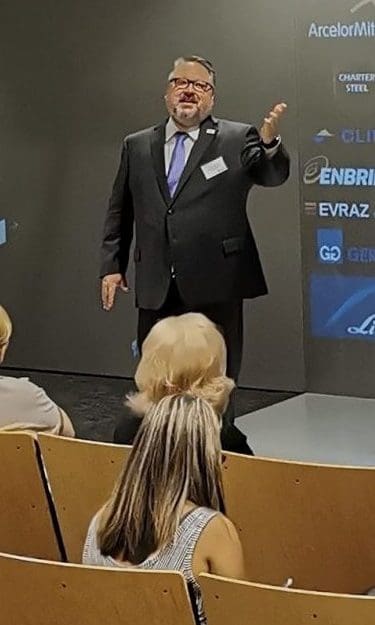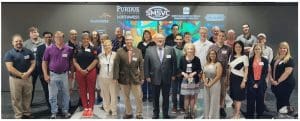NSF Research Experience for Teachers (RET) Welcomed for Six Week Summer Program at CIVS

PNW Provost Kenneth (Chris) Holford
Welcome NSF RET teachers! The opening ceremony for the high school and community college teacher’s summer program was held at the Center for Innovation through Visualization and Simulation (CIVS) immersive theater on June 14th. Sponsored by National Science Foundation (NSF) Research Experience for Teachers (RET) program, twelve teachers will spend six weeks to gain research experience by using simulation and visualization technologies to solve real-world problems in the areas of blast furnace, reheating furnace, crane, and safety. The RET teachers are from local schools including Munster, Homewood-Flossmoor, Merrillville High School, Whiting High School, Bloom High School, Bishop Noll High School, and Portage High School, and Ivy Tech Community College.
During the ceremony, the RET teachers were warmly welcomed by PNW Provost, Dr. Kenneth (Chris) Holford; Interim Dean of the College of Engineering and Science (CES), Dr. Dietmar Rempfer; Department Chairs: Drs. Nesrin Ozalp (Mechanical and Civil Engineering), Catherine Murphy (Computer Science, Physics and Chemistry), Nicoleta Tarfulea (Math & Statistics), and Barbara Mania-Farnell (Biology and Health Science); RET Program Directors: Drs. Chien-Chung Chen (Civil Engineering), and Chenn Zhou (CIVS Director). CIVS staff members and student research mentors also joined the event.

This teachers program, which will take place over three summers, is the first NSF RET site in Northwest Indiana. This program has three objectives: (1) To provide high school and community college teachers with authentic research experiences using advanced simulation and visualization technologies to solve real-world industrial problems and transfer those experiences back to their classrooms; (2) To translate teachers’ research experiences and knowledge into curricular modules, using existing real-world virtual industrial processes, that will be implemented in their STEM classes during the academic year; and (3) To build a community of educators and engineers who will continue to collaborate, promote research and practical application of simulation and visualization technologies, advance STEM learning and career paths, and provide inspiration for students.
